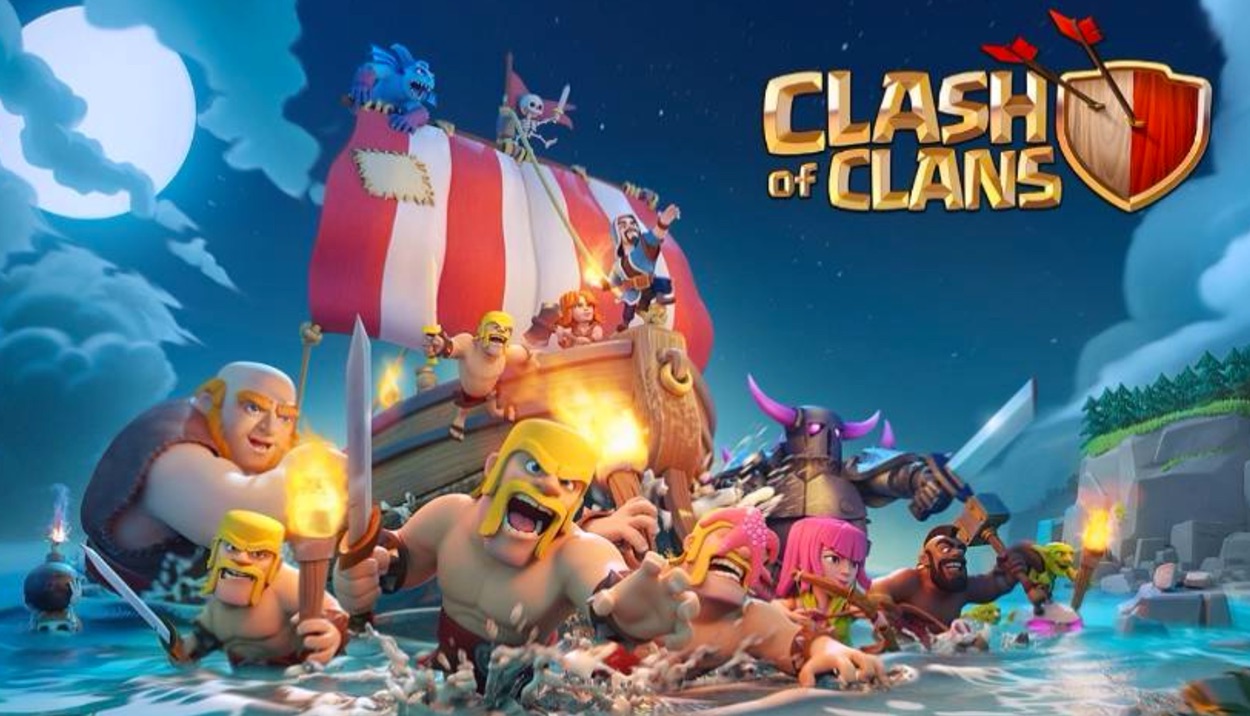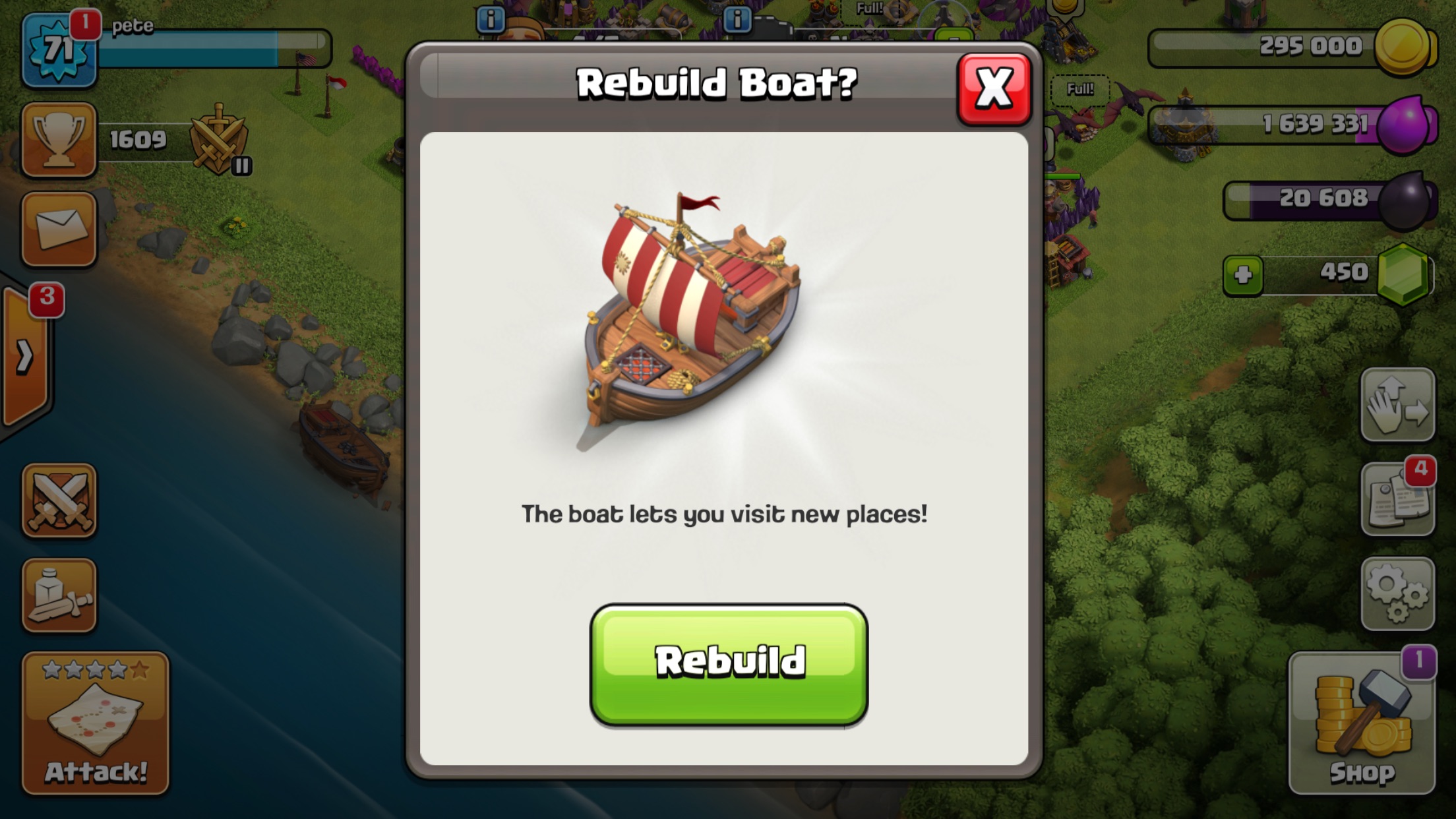Deconstructing "Clash of Clans 2: The Builder Base"
Clash of Clans is a household name for most smartphone users, and for game makers, a perennial face on the top grossing charts. For years, the base-building, clan-battling midcore phenomenon has retained players more successfully than almost any game released since the iPhone was introduced. Supercell has achieved this without major changes to the core loop, and with updates focusing on additional troops, balance improvements, and features that drive additional social gameplay.
So when the developers placed a mysterious new building on Clash of Clans bases, players were rightfully excited. The building - a capsized ship situated on the eastern shore - was placed without context except for a small teaser video. For weeks, Supercell dripped additional clips, riling up the community which speculated wildly on what new features the vessel would unlock. But one thing was certain – that after almost 5 years since the game was released, it was getting the biggest update yet.
Enter: The Builder Base
When the long-awaited update finally dropped, player were able to fix-up the boat and travel far across the ocean to their new home: a second base which Supercell calls the Builder Base.
When players first visit this area, they will realize three main takeaways. First, the base appears to be laid out largely the same as the traditional village, as far as the main aspiration and core loop is concerned. Players need to build buildings, upgrade them to improve their capabilities, and train troops to engage in battles against other players.
Secondly, while everything may look the same, mechanically the game operates very differently. From where players acquire the majority of their resources, to how the battles are structured, everything is familiar but the underlying mechanics have all been redesigned.
And lastly, Supercell reset all progress to zero for this new area. Regardless of their original investment of time and money in Clash of Clans, all players enter the new base as newbies. While clashers can play both the traditional base as well as the new builder base, resources are not shared between villages, and trophy rankings are completely distinct. This is about as close to Clash of Clans 2 as we’re likely going to ever see. More on that later.
What’s the same?
The core loop hasn’t changed much, meaning that players are tasked with collecting soft currency resources - Elixir and Gold - which are used to upgrade their buildings and level up their troops. Players engage in player-vs-player battles, and by winning these, increase their trophy ranking. Defensive buildings and their placement in the village is used for defending other players’ attacks.
The only main difference in the two core loops is that instead of constructing troops with Elixir, the units are automatically built for free. The game emphasizes upgrading the troops, much like in Clash Royale, as opposed to simply amassing more total units. The addition of automatic troop building also fixes the negative experience of returning to the base after a period of time, and seeing that you forgot to train an army before you left, as in the original clash base, armies can take 30 minutes or more to be trained completely.
Using Joe Traverso’s definition of a core loop, we see a small shift in how the user collect the main resources.
Original Village: Collect Resources from buildings so you can Train an Army which lets you Level Up the Town Hall
Builder Base: Attack With Troops to get resources to Upgrade Your Troops, which lets you Level Up the Town Hall
By keeping the core loop mostly unchanged, Supercell ensures that onboarding of the new base is easily accessible to all players. However, the trophy ranking are not shared across the old and new bases, as are soft currencies and number of builders, so in essence Clash players have stumbled on a new game entirely.
What’s Different:
What you will see is a hybrid version of Clash Royale and Clash of Clans. Supercell looked to add the synchronous, real time battling mechanics of Royale, coupled with its high degree of unit customization and placement importance, and added it to the familiar base-building core loop. In some ways, the Builder Base is more like Clash Royale than the original Clash of Clans village.
In the Builder Base, you also only have 1 builder, which means you can only be upgrading one building at a time. There is also no option to purchase another one - a big change from the previous base, and one that slows down progression significantly.
Ultimately, some of changes Supercell put forth in the latest update are stellar. Some of them, not so much. And the execution leaves a lot to be desired.
The Good: Real Time Battles
The battle system in Clash of Clans Builder Base is the most important change, and also the most welcome.
The traditional Clash is an asynchronous, mostly solo experience. A player builds an army to take for a raid, scouts and finds a base with enough resources to capture, and then attempts to place their units strategically in order to steal resources from the opponent. The defending player doesn’t necessarily get to attack
back, and doesn’t need to be online in order to be raided. Additionally, an attacking player may get resources even if they didn’t earn at least one star - the minimum amount for the attack to be considered a win.
The new system takes a more competitive approach. When a player searches for a battle, they are matched with another player also online looking for a match, and then the two attack each other simultaneously. The player who destroyed the largest percentage of the enemy base is the winner, and receives a fixed reward for the victory based on their current level. The loser receives nothing, but also doesn’t forfeit any resources for trying.
The simultaneous approach mirrors the gameplay seen in Clash Royale - as players are battling each other in real time, and likely uses the same technology and matchmaking backend. The concept of a winning and losing is a positive change, and imbues importance to individual unit placement because each building destroyed matters a lot more than in the original Clash of Clans village.
Lastly, with the growing emphasis on mobile esports, the true player-vs-player attack structure lends itself for tournaments and other competitive formats down the line. While those features aren’t in this update, Supercell has already built such a system in Clash Royale to spectate VIP player’s games, and it would not surprise me if we see this in Clash of Clans in a future update.
Also Good: Unit Construction and Upgrades
In the original Clash village, players must choose whether or not to spend resources in order to construct troops. If a player is trying to save resources for a big upgrade, such as upgrading their Dragon troops, they will not be incentivized to create an army. This is a design flaw in Clash of Clans, or a key strategic choice, depending on how look at it.
In the Builder Base, this min-max decision doesn’t exist, because troops do not cost any resources to build, and are trained automatically after a player loses the previous army in a battle. Each army camp takes 1 minute to refresh with troops, so with the maximum of 5 army camps, players only need to wait a max of 5 minutes before attacking again. With these resource and timer choices removed, players can really focus in on the strategy of attacking and engage with this important part of the game without fear of misusing resources.
Because players are free from the minutiae of micromanaging soft currencies for their troop selection, the game plays out a lot like Clash Royale would. Players have a certain amount of Army Camp slots, and need to select their “cards” to occupy that spot.
Also keeping in line with the Supercell CCG, the Builder Base relies heavily on upgrading the troops, with more so than in the original village. Each unit has a special ability, which makes them more interesting, and their upgrade sequence more meaningful. The depth of the upgrade system in the Builder Base is also important - as each upgrade improves not only the damage of the unit, but also improves either its abilities, number of units at each Army Camp, or hit points. For example, the Sneaky Archer Level 8 upgrade improves its cloaking ability, and its Level 9 upgrade improves its damage per second and hits points. The Level 10 upgrade gives you 2 more Sneak Archers available at the Army Camp.
One other key element of the Builder Base attacking system is how players do not need to “pre-select” their units that attack. When players are matched, and are able to see the opponents layout, they can then swap their current units out with any other type. This removes the need cycle through opponents to get a favorable matchup, as is the case in the original village, and makes the battle more skill-based.
On the defensive side of things, Supercell released a number of new buildings to help players secure their base. A Double Cannon, Crusher, and a host of new traps. An interesting development for many of these buildings is the choice of modes. For example, the Archer Tower can be in Long Range mode, with a slower attack speed, or in Short Range mode with a high attack speed. Similarly, some traps can be set to Air or Ground, but not both. This added layer of defensive strategy is a welcome addition, and can help formulate a rock-paper-scissors metagame.
Special Buildings:
Lastly, there are two interesting buildings that appear on the Builder Base map that are unique to this update, and create an added incentive to check in on the sub-base. The Gem Mine can be uncovered which doles out free gems, and the Clock Tower allows the user to periodically fast-forward a few minutes of time within the Builder Base, good for skipping some of the smaller wait timers littered throughout the game. Supercell wanted to make sure that players are visiting the Builder Base regularly, so these buildings add an extra incentive.
The Bad: The Attack Pinch
If all these new and exciting units and new attack mode sound exciting to you, you are not alone. And while you are enjoying all the fun of exploring a new world, you will be hit with the attack cap, and the fun suddenly comes to a screeching halt.
You can attack to gain resources only three times in 24 hours in the Builder Base, and since the attacking represents the main way players acquire resources, progression is slowed to a crawl. While you may still attack for practice or to rank up the trophy count, resource collection is ultimately stopped until the timer resets. To bypass this attack cap with gems, players will need to spend the equivalent of $2 worth of premium currency, a hefty price for only three more attacks. This hefty price is a heavy handed way of telling players that, while the new expansion is fun, the real game is back at the old village. However, it’s inelegant to
What might have been a more elegant solution was sticking with the Clash Royale model - where even after the player has hit the maximum amount of chest rewards for winning, they are still earning a small amount soft currency for each win. In this way, it still limits the progression of the most engaged players, while not punishing players for engaging in the core loop. Additionally, there are other rewards for continued play - such as the daily Crown Chest, as well as arena tournaments and Clan Chests events.
This solution not elegant, and gives off a very pay-for-play vibe, something that midcore players are highly sensitive to. Additionally, you can tell that Supercell was very conscious of not letting players get too far ahead of the content, since players are not able to purchase an extra builder in the Builder Base. Regardless, this feature makes the new Builder Base appear as only a mini game, despite it’s innovative combat design.
The Ugly: What’s the Point?
The execution and launch strategy of the Builder Base is ultimately a harbinger of declining performance of Clash of Clans. After five years, their most dedicated players have run out of things to do within their base.
The update alienates these engaged users. The years of invested time and money into Clan bases becomes moot after this update, which could have been avoided if there was meaningful shared progress or resources between the two bases. There was ample opportunity to make the two experiences more interconnected, but instead the Builder Base was released as sequel to Clash of Clans, inside of itself.
Secondly, Supercell will be at a crossroads if this new attack system becomes the more desirable experience. Which base will become the default experience for new users after installing? Will they need to prioritize building features for one base over the other? As far as esports can be concerned, isn’t it strange to have players compete in what is essentially a mini-game within another product?
One might look and see that Clash has shown signs of strong revenue after the release of this update. Yet, this is to be expected after any large content drop, and when the dust settles, players are left with two distinct games with no clear direction on the importance of either.
Lastly, this format changeup is something we have seen before. A couple of years after its release, Hearthstone changed up the competitive structure by creating the Standard format of play, only allowing cards from the most recent sets to be played. This format similarly alienated the invested playerbase - and Hearthstone struggled to maintain their user base and fell from the top charts on mobile. They have since had to invest in re-engagement features to gain back users. While it is difficult to attribute the drop in revenues to strictly the Standard format addition, from a design perspective, those who spent money and invested in older cards would feel frustrated, and may be hesitant to spend again in the future.
Is this the beginning of the end for Clash of Clans, or the beginnings of a new era?
Time will tell. I believe that players will be more hesitant to invest in their original base, and similarly for the Builder Base, since exactly how the game mode will be prioritized by Supercell remains to be seen. It would have been wiser to let the Builder Base spend more time in development, generate more content, and release the mode as a standalone sequel. The experiences are different enough, and Clash Royale has shown that they can monetize multiple games without cannibalizing their own revenues.
If one base in Clash of Clans is significantly more balanced or fun than the other side, players will eventually play there. This puts a massive task on the designers to keep up two games simultaneously or risk breaking the whole game. If Clash’s mechanics cannot support players using only playing half the game, the players might just get frustrated and churn out.
From a design perspective, Clash of Clan’s new attack system is a sure improvement. It paves the way for another mobile esport, is more social in nature, and rewards skill and strategy. However, through the attack limitation and the lack of overlap with the original village, the experience gets relegated as merely a minigame. Despite the design improvement, the biggest update in Clash of Clan’s history may fall short of expectations in the long run.















